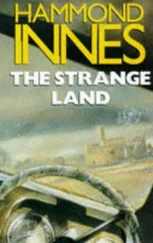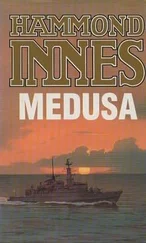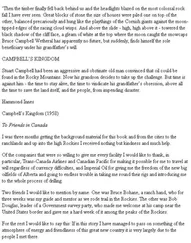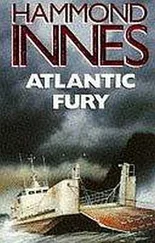Hammond Innes - Dead and Alive
Здесь есть возможность читать онлайн «Hammond Innes - Dead and Alive» весь текст электронной книги совершенно бесплатно (целиком полную версию без сокращений). В некоторых случаях можно слушать аудио, скачать через торрент в формате fb2 и присутствует краткое содержание. Жанр: Морские приключения, на английском языке. Описание произведения, (предисловие) а так же отзывы посетителей доступны на портале библиотеки ЛибКат.
- Название:Dead and Alive
- Автор:
- Жанр:
- Год:неизвестен
- ISBN:нет данных
- Рейтинг книги:3 / 5. Голосов: 1
-
Избранное:Добавить в избранное
- Отзывы:
-
Ваша оценка:
- 60
- 1
- 2
- 3
- 4
- 5
Dead and Alive: краткое содержание, описание и аннотация
Предлагаем к чтению аннотацию, описание, краткое содержание или предисловие (зависит от того, что написал сам автор книги «Dead and Alive»). Если вы не нашли необходимую информацию о книге — напишите в комментариях, мы постараемся отыскать её.
Dead and Alive — читать онлайн бесплатно полную книгу (весь текст) целиком
Ниже представлен текст книги, разбитый по страницам. Система сохранения места последней прочитанной страницы, позволяет с удобством читать онлайн бесплатно книгу «Dead and Alive», без необходимости каждый раз заново искать на чём Вы остановились. Поставьте закладку, и сможете в любой момент перейти на страницу, на которой закончили чтение.
Интервал:
Закладка:
Shortly after Bill’s return Jack Dugan had the auxiliary going and the lights on.
We were pretty excited that night for tomorrow was the great day — we should know whether we were going to be able to shift the deadweight of the stern with the tackle we had. I was frankly worried. The girders were strong, but the stern, which carried the two 500 h.p. engines, was a hell of a weight. Stuart and I sat smoking on the deck and talking over all the possibilities long after Bill and Anne had driven off with Dugan.
They returned with him early next morning. Working with pulleys, we had already got two of the girders in position and chains slipped underneath the hull. They were as excited as we were. ‘If you want any help, sir,’ Dugan said, ‘give me a shout.’ And he disappeared down the engine-room hatch.
The method by which I had planned to move the ship was primitive and laborious, but at the same time simple. On the landward side of the stern I rigged two girders like legs astride and bolted together at the top, to which I affixed a pulley bearing a triple chain which ran beneath the hull. To the top of the girders I also fixed a rope, ran it round one of the bollards and then pushed the girders out till they slanted away from the side of the ship at an angle of about twenty degrees out of the perpendicular. On the seaward side I did the same, but the girders were planted well away from the ship’s side and slanted at the same angle towards the ship. The triple chain was brought up from beneath the hull and fixed to the pulley. To the apex I fixed a second pulley and attached it to a short hawser which I ran around a big outcrop of rock on the far side of the cove. Hauling on the pulley, we made this taut. And then we did the same to the other pair of girders.
By midday everything was set for the first move.
With Stuart and Boo on the landward girders’ pulley and Bill and myself on the seaward we began to put the weight of the ship on to the girders. They bedded down, grating on the rock base of this section of our ramp. Then inch by inch the stem began to lift clear of the rock on which it rested.
When the hull was six inches clear, I ordered a halt and we manned the pulleys that bore on the hawser attached to the girders on my side and also the one that bore on the long hawser that ran direct to the ship. I called Dugan up and set him to slacken off on the pulley on the landward side.
Slowly, as we hauled on the pulleys, the girders swung into the perpendicular. The stern was then two feet clear of the rock. I was scared that the tackle would break then. It wouldn’t matter so much when she was fully on our sand ramp. But if she dropped two feet on to rock she’d be holed for certain.
But the tackle held. The girders gradually slanted over in our direction until at length the hull was resting on the ground again. But now she was no longer lodged on the flat rock she had rested on for nearly a year. She was on the ramp we had built. We had swung the stern just over six feet.
In a long and pompous after-lunch speech Stuart publicly presented me with a tin of bully beef in token of the company’s ‘gratitude for my astonishing engineering feat,’ regretting at the same time that at such short notice they had been unable to obtain the packet of ‘V cigarettes that should have accompanied the gift.
We achieved another move during the afternoon. And after tea, as we prepared for the third, the cove echoed to the stuttering roar of the starboard engine. We all gathered round the stern as Dugan set to slow ahead. The propellers turned and we knew we would be able to get out of the cove under our own steam.
We did a third move before the sun set. The stern was by then well on to our ramp and the whole hull was slanting diagonally across the end of the cove. After dinner, working by flashlight, Stuart and I rigged rope ties for’ard and the second long hawser taut to the ship. I was taking no chances with a change in the weather.
By the following evening she was off the ramp on flat sand, pointing stern first straight towards the entrance of the cove. At high tide that evening the waves were breaking against her propellers.
A day of disappointment followed. We ran the long hawsers to the capstan and short hawsers with pulleys to the bollards on either side of the stern. With two of us manning each pulley and the engines working the capstan, she refused to slide on the sand. She wouldn’t even budge with rollers under the stern. She just ground them into the sand, and that with the tide lapping all round her. All we succeeded in doing was breaking one of the long hawsers.
We patched it and settled down to the laborious task of frog-marching her into the water by cradling her on the girders as we had done when shifting the stern across the ramp. The one bright spot in the whole day was that Dugan got the port engine going.
The next morning it began to blow. Dugan confirmed my view that it was blowing up dirty and we spent a back-breaking morning running out all the hawsers and rope we had to lash her into position. By midday it was blowing half a gale and the wind was roaring up the cove from the open sea. The low tide barely cleared the rocks at the entrance and the waves were breaking in a smother of spray against the Elephant Rock. As the tide thun dered in, the cove was filled with a mist of driven spume — the wind whipped it off the creamy breakers and flung it in a stinging rain against out faces as we stood watching the advancing tide.
Stuart’s lips mouthed curses at the elements, but the sound of his words was whipped away by the wind and given to the cliffs behind us.
High tide was shortly after five and by that time great shaggy combers, blurred in spray, were thundering on to the beach and breaking in a cascade of foam against the stern. Every time a wave broke the ship lifted, suddenly buoyant, and as the water sucked back she settled with a thud that jarred her whole frame. The long hawsers slackened and tautened with monotonous regularity as though some great giant were plucking at them as part of the orchestra of the storm. Between the breakers they whipped and thumped at the water like galvanized eels. Every now and then there was a sickening crash against the stern plates as a rock from the demolished ramp was flung against the ship.
Suddenly Stuart pointed. A great wave was piling into the entrance, gathering height as it was contained by the narrowing cliffs. We clung to the deck stanchions and watched it swirl in, its angry, wind-whipped crest jostling in a pyramid of surf. It broke, a mountain of green and white, slap against the stern. A cataract of water swept green over the ship. It hit me in the chest, winding me and wrenching at my arms. The ship bucked like a live thing. I felt one of the starboard hawsers snap and through the flurry and foam of the spent wave I caught a glimpse of the broken end of the long hawser coiling over the stack like a great snake. It hit the deck with a thud as the water began to seethe from under us. Then the ship thudded down with a hard grinding sound.
‘Rock,’ yelled Stuart. He had a slight gash on his forehead where his head had been flung against the sides of the stanchion to which he was clinging.
No doubt about it. The sand had been sucked back from beneath the ship and we were on the rocks. The hull was grating horribly as the ship yawed to port, straining at the short hawser that was now the only hold on the starboard side.
‘We must tighten that hawser,’ I yelled in Stuart’s ear.
He nodded and we went right aft to the bollard that held the hawser. But the chain of the pulley had been ripped from the stanchion to which it had been attached. The double loop hung trailing in the surf. The next wave seemed insignificant after its predecessor, but the grating of the bottom on the rocks was a wicked grinding sound even in that pandemonium of wind and water.
Читать дальшеИнтервал:
Закладка:
Похожие книги на «Dead and Alive»
Представляем Вашему вниманию похожие книги на «Dead and Alive» списком для выбора. Мы отобрали схожую по названию и смыслу литературу в надежде предоставить читателям больше вариантов отыскать новые, интересные, ещё непрочитанные произведения.
Обсуждение, отзывы о книге «Dead and Alive» и просто собственные мнения читателей. Оставьте ваши комментарии, напишите, что Вы думаете о произведении, его смысле или главных героях. Укажите что конкретно понравилось, а что нет, и почему Вы так считаете.












